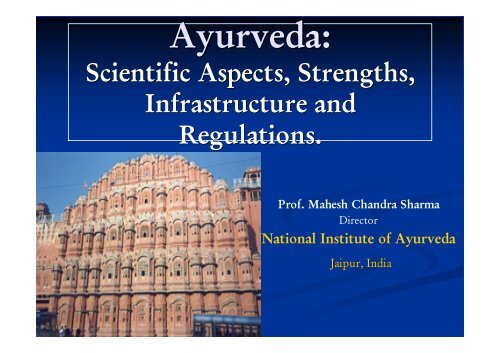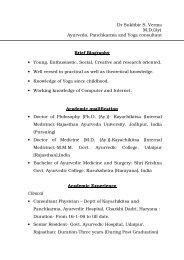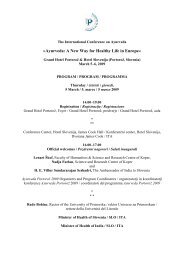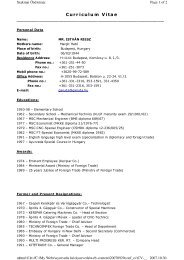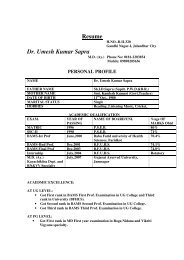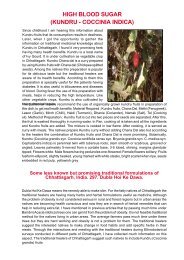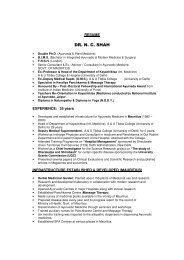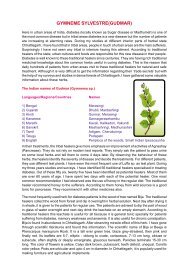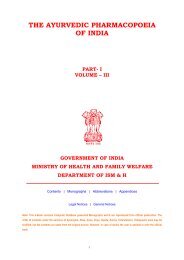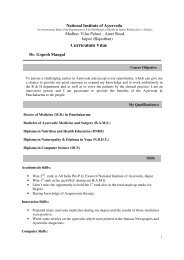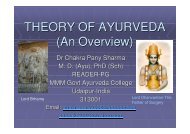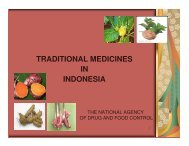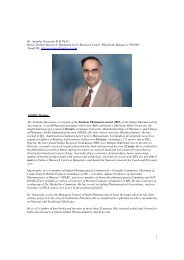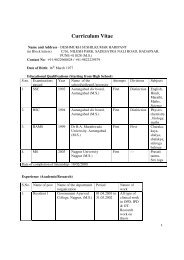antiarthritic drugs
antiarthritic drugs
antiarthritic drugs
Create successful ePaper yourself
Turn your PDF publications into a flip-book with our unique Google optimized e-Paper software.
Ayurveda:<br />
Scientific Aspects, Strengths,<br />
Infrastructure and<br />
Regulations.<br />
Prof. Mahesh Chandra Sharma<br />
Director<br />
National Institute of Ayurveda<br />
Jaipur Jaipur, , India
Kindly allow me to start at the very beginning…<br />
No ‘unified’ theory explains Man –<br />
Universe relationship despite<br />
centuries of quest for it by the<br />
greatest minds…<br />
The PANCHA MAHABHUTA<br />
Model of Ayurveda is a probable<br />
answer
Panchamahabhuta Biological<br />
applications of<br />
AKASHA<br />
VAYU<br />
TEJA<br />
JALA<br />
PRITHVI<br />
Fundamental Principle:<br />
Unity of Man and Universe<br />
Panchamahabhuta<br />
VATA<br />
(Motional energy)<br />
PITTA<br />
(Chemical activities)<br />
KAPHA<br />
(Solid substratum)
Art work by Dr.<br />
D’Lynn Waldron.<br />
BASIC CAUSE OF DISEASE<br />
LACK OF HARMONY<br />
Between<br />
ENVIRONMENT (Loka ( Loka) ) & MAN (Purusha ( Purusha)<br />
Ayoga (Absence Absence), ), Atiyoga (Excess Excess) ) or Mithyayoga<br />
) Kaala (Time factor and its chronological influence), ,<br />
Due to Ayoga<br />
(Abuse Abuse)<br />
Buddhi (Intellect of man is the major source of thought<br />
information and its consequences) & Indriyartha(Objects Indriyartha of<br />
the Senses are the major hubs of information exchanges)
Some Salient Applied Aspects:<br />
�� Concept of Prakriti (Constitution)-<br />
(Constitution)<br />
The Total Personality: Physique,<br />
Physiology & Psyche
Scientific Concepts of:<br />
�� Aahaara (Diet Diet), ),<br />
�� Nidra (Sleep eep) ) and<br />
Brahmacharya (Regulated Regulated Sexual<br />
Activity) Activity<br />
�� Brahmacharya<br />
)<br />
�� are stated to be the 3 pillars of Health<br />
and can be seen in the modern light of<br />
Lifestyle management of health.
� Safe<br />
Ayurvedic<br />
Medicines<br />
� Cost effective<br />
� Natural<br />
� Acceptable<br />
� Holistic
International Recognition:<br />
� In view of the Principled, Codified and Systematic<br />
approach and strengths of Ayurveda, the Walton<br />
Committee appointed by the House of Lords, UK,<br />
put Ayurveda medicines in the Group-1 scientific<br />
category of professionally practiced<br />
Complementary & Alternative Medicine.<br />
� About 20 years back, W.H.O. adopted<br />
Traditional Medicine programme in conjunction<br />
with the goal of health for all with the adoption of<br />
primary health care approach. W.H.O. has an<br />
open mind on Traditional Medicine. However, it<br />
endorses only that therapy which has solid<br />
scientific evidence with no toxicity. In view of this<br />
Ayurveda is duly recognized by W.H.O.<br />
� Training : UG- GAU, Jamnagar<br />
�� PG PG- NIA, Jaipur Jaipur, , GAU, Jamnagar
The Huge Infrastructure of AYURVEDA in India<br />
today indicating the signs of a Living Tradition<br />
Parallel to Allopathic system<br />
� Registered practitioners: 443634<br />
� Number of Colleges: 227<br />
� PA Admission Capacity for degree courses: 11197<br />
� Postgraduate colleges: 67<br />
� PA Admission Capacity for PG courses: 977<br />
� Licensed Drug Manufacturing Units: 7802<br />
� Hospitals: 2394<br />
� Beds in hospitals: 42087<br />
� Dispensaries: 13887
National level Institutions of Ayurveda<br />
� National Institute of Ayurveda, Jaipur<br />
� Institute of Postgraduate Training & Research in Ayurveda,<br />
Jamnagar<br />
� Gujarat Ayurveda University, Jamnagar<br />
� Rajasthan Ayurveda university, Jodhpur<br />
Regulation of Education & Practice of Ayurveda in India<br />
Central Council of Indian Medicine (CCIM) for<br />
Ayurveda, Siddha & Unani systems established under<br />
Indian Medicine Central Council Act, 1970.
NATIONAL INSTITUTE OF AYURVEDA<br />
Jaipur<br />
The Institute imparts teaching<br />
and training for -<br />
• Under-Graduate (BAMS) – 60 per year<br />
• Post-Graduate (MD- Ayurveda) – 55 per yr<br />
• Ph.D. program.- – 15 per year<br />
• Foreigners Training program.<br />
HOSPITALS<br />
The Institute has 2 affiliated hospitals -<br />
1. Institute Hospital (Madhav Vilas Hospital )situated in the campus and<br />
2. Seth Suraj Mal Bombaywala Hospital<br />
OTHER FACILITIES<br />
• Classrooms well equipped with latest Audio Visual facilities<br />
• Highly qualified and experienced faculties.<br />
• Use of latest Information Technology for teaching & Research.<br />
• Ayurvedic Drug Manufacturing Unit.
Regulation & Quality control of<br />
Drugs<br />
� The regulatory Act and the Rules thereunder are common<br />
for allopathic and Indian medicines & homeopathic <strong>drugs</strong>.<br />
There is a separate chapter for Ayurveda, Siddha and<br />
Unani medicines introduced since 1982 in the Drugs &<br />
Cosmetics Act, 1940.<br />
� The Drugs & Magic Remedies Act, 1954 provides for<br />
provides for prohibition of advertisements of certain <strong>drugs</strong><br />
and magic remedies for treatment of certain identified<br />
diseases and disorders and for prohibition of import in to<br />
and export from India of certain advertisements relating to<br />
<strong>drugs</strong> that may mislead the public.<br />
� Good Manufacturing Practices For Ayurvedic, Siddha And<br />
Unani Medicines Notified Under Drugs & Cosmetic Act<br />
1940 On 23rd June 2000
Pharmacopoeia & Formularies<br />
�� Pharmacopoeial standardization of <strong>drugs</strong> is mandatory as per<br />
Drugs & Cosmetics Act, Act,<br />
which was amended in 1964 to bring<br />
under its purview Ayurveda, Siddha and Unani <strong>drugs</strong>.<br />
�� Pharmacopoeial Laboratory of Indian Medicine was set up in<br />
1970<br />
�� Ayurvedic Formulary of India containing 444 compound<br />
formulations in 1978.<br />
�� Subsequently in the year 1986, first volume of Ayurvedic<br />
Pharmacopoeia with 80 monographs of single plant <strong>drugs</strong> was<br />
published. Presently 5 volumes covering 418 plants are available. available<br />
�� 13 laboratories of certain universities & scientific institutions<br />
institutions<br />
have been engaged apart from Pharmacopoeial Laboratory of<br />
Indian Medicine.<br />
�� These laboratories are also evolving Standardized Operating<br />
Procedures (SOPs) of Ayurveda <strong>drugs</strong>.
Research & Development<br />
The mandate of Research & Development in literary, clinical and drug areas;<br />
survey, validation and documentation of tribal and folk-lore practices &<br />
remedies and other scientific activities related to respective systems is assigned<br />
to central research councils.<br />
� Central Council for Research in Ayurveda & Siddha<br />
(CCRAS)<br />
� Central Council for Research in Unani Medicine<br />
(CCRUM)<br />
� Central Council for Research in Homeopathy (CCRH) and<br />
� Central Council for Research in Yoga & Naturopathy<br />
(CCRYN)
Thrust to Medicinal Plants Sector<br />
One National Medicinal Plants Board<br />
�� 30 State Medicinal Plant Boards<br />
�� One National Medicinal Plants Board<br />
30 State Medicinal Plant Boards<br />
� to coordinate the activities of development of medicinal<br />
plants sector in a concerted manner.<br />
� The objective of this arrangement is to streamline<br />
Conservation & Cultivation, Demand & Supply,<br />
Research & Development, Trade & Export, Quality<br />
Control & Standardization of medicinal plants &<br />
products.<br />
� 32 medicinal plants used in the manufacture of Ayurveda,<br />
Siddha, Unani and Homeopathy medicines are prioritized<br />
for large-scale cultivation through organic farming and<br />
use of agro-technology.
Some Important Researches on Ayurvedic<br />
Medicinal Plants:<br />
�� Brahmi (Bacopa Bacopa Monnieri Monnieri) :<br />
regulates brain biogenic amines and<br />
influences the discrimination of<br />
learning. – Dubey GP in Ayurveda & its Scientific<br />
aspects P: 126, CSIR & AYUSH, 2006<br />
�� Ashwagandha (Withania Withania<br />
somnifera somnifera): ): Relieves Stress and<br />
Anxiety.<br />
�� Arjuna (Terminalia Terminalia arjuna arjuna): ):<br />
Effective in management of CVD.<br />
Good cardio cardio-protective protective<br />
�� Guduchi (Tinospora Tinospora cardifolia cardifolia): ):<br />
Immunomodulator<br />
Immunomodulator.<br />
�� Vijayasar (Pterocarpus<br />
Pterocarpus marsupium<br />
marsupium): ):<br />
Anti diabetic
Initiative for protection of Traditional<br />
Health Knowledge and Research<br />
��<br />
sharing<br />
In order to prevent patenting of claims emerged from<br />
traditional knowledge that already exists in public domain,<br />
the Government has taken in hand an ambitious project of<br />
development of Traditional Knowledge Digital Library for<br />
Ayurveda, Unani, Unani,<br />
Siddha and Yoga.<br />
�� First phase of Ayurveda TKDL is over, which contains<br />
36,000 formulations described in 14 Ayurvedic texts.<br />
�� The digital library is prepared in English, Hindi, Spanish,<br />
French, German and Japanese languages in international<br />
patent compatible format<br />
�� Golden Triangle Project:<br />
AYUS<br />
H<br />
ICMR CSIR
AREAS OF STRENGTH OF AYURVEDIC MEDICINE<br />
WHERE RECENT RESEARCHES HAVE<br />
YIELDED LEADS<br />
� ANTISTRESS AND NEURO ACTIVE DRUGS<br />
� IMMUNOMODULATORS AND ADAPTOGENS<br />
� ANTIARTHRITIC DRUGS<br />
� CARDIO PROTECTIVES AND HYPOLIPIDAEMICS<br />
� ANTI DIABETICS<br />
� PANCHAKARMA AND KSHARSUTRA TREATMENT
Globalization, International<br />
Cooperation & Collaboration<br />
Apart from<br />
neighboring countries<br />
like Sri Lanka, Nepal,<br />
and Mauritius,<br />
Ayurveda has been<br />
recognized as a system<br />
of health care in<br />
Hungary.


